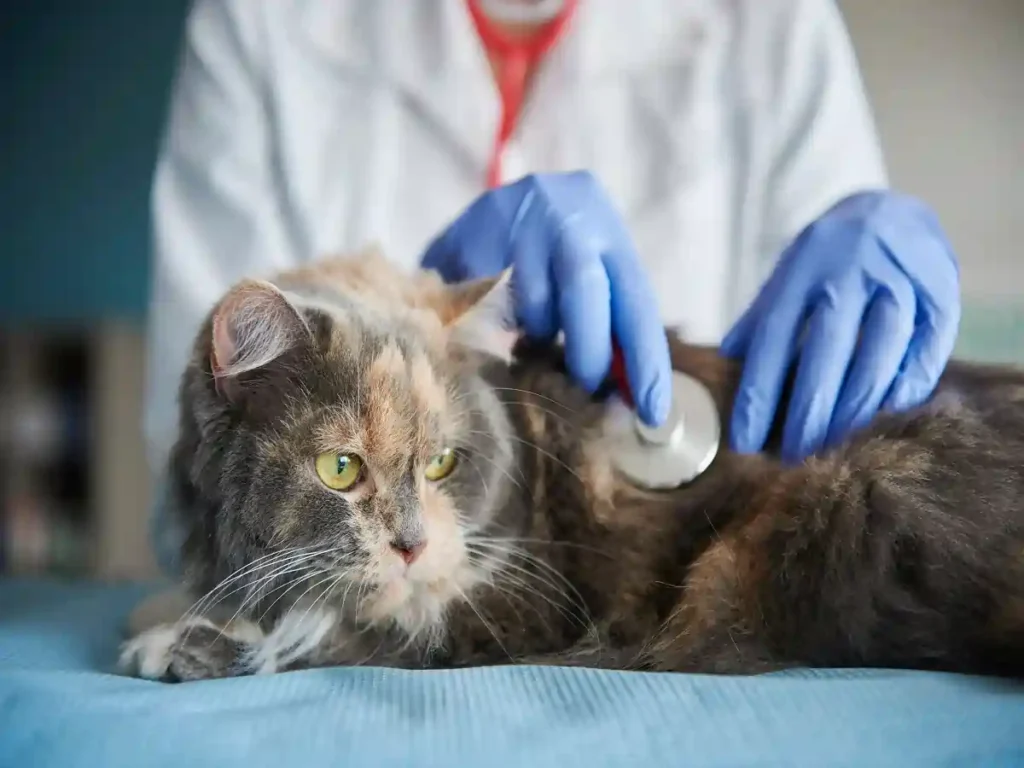Cats are cute pets known for being independent and doing quirky things. But sometimes cats peeing on clothes or other things in the house can be a frustrating behaviour for pet owners. But why do cats do this? understanding these reasons can help address the issue effectively.
Cats might pee on clothes for different reasons, like feeling stressed, marking their territory, or having health issues such as urinary tract infections or kidney problems. They could also do it if they smell their owner’s scent on the clothes and want comfort or attention.
In this article, we will cover common reasons why cats pee on clothes. How to identify potential triggers, and strategies to prevent and manage this behaviour effectively.
Table of Contents
ToggleUnderstanding Feline Behaviour: Why Your Cat Chooses Your Clothes
Cats are known for being independent and sometimes do things that confuse or upset their owners. One behaviour that can be frustrating is when cats pee on clothes. It might seem like they’re doing it on purpose, but there are reasons behind it that we need to understand.
Instinctual Behaviours:
Cats naturally protect their territory, and they pee to mark it as theirs. When a cat pees on clothes, it is like they are saying, “This is mine”. Also, cats have scent glands in their paws. They knead things to mark them with their scent. Peeing on clothes after kneading could be a way of saying, “This belongs to me.”
Stress and Anxiety:
Sometimes, stress and worry can make a cat pick a certain spot to pee. Changes at home, like getting a new pet, moving to a new place, or even just a different routine, can make cats feel stressed out. Peeing on clothes might be a way for cats to deal with feeling extra stressed or anxious.
Medical Considerations:
It is important to check if your cat has any health problems causing its behaviour. Things like urinary tract infections or bladder stones can make peeing painful for cats. This might make them choose other places to pee. Talking to a vet is crucial to find out if there are any medical reasons for this.
Medical issues might not directly make cats pee on clothes, but they can make the problem worse. Here’s how medical problems can affect this behaviour.
Urinary Tract Infections (UTIs):
UTIs are infections caused by bacteria in the urinary tract, which includes the bladder and urethra. Cats with UTIs might feel pain when they pee, so they may avoid using the litter box. Instead, they might pee on clothes to try to ease their discomfort.
Bladder Stones or Crystals:
Bladder stones or crystals are tiny rock-like deposits that can form in a cat’s bladder. They can cause irritation, swelling, and even blockages in the pee tubes. Cats with bladder stones or crystals might feel pain or discomfort when they pee. This can make them avoid using the litter box and pee on soft things like clothes to feel better.
Urinary Obstructions:
Urinary obstructions happen when something blocks pee from coming out of the bladder. It could be a stone or a thick blob of mucus. Cats with urinary obstructions might try to pee often, struggle to pee, and cry out in pain. If not fixed quickly, urinary obstructions can be very dangerous. Cats might pee on clothes or other things if they can’t pee normally because of the blockage.
Feline Lower Urinary Tract Disease (FLUTD):
FLUTD is a bunch of problems that affect a cat’s pee system. It includes things like bladder inflammation (cystitis), pee infections, and pee blockages. Cats with FLUTD might pee a lot, struggle to pee, have blood in their pee, and pee outside the litter box. Because FLUTD hurts, cats might skip the litter box and pee on clothes or other soft stuff instead.
Other Health Problems:
Some other health issues, like diabetes, kidney problems, arthritis, and nerve disorders, can also affect how a cat pees. Cats with diabetes or kidney problems might drink and pee a lot more, which can make them pee outside the litter box more often. Arthritis or nerve problems can make it hard for cats to get to the litter box or pee in the right position, so they might look for other places to pee.
Top of Form
Environmental Factors:
How the litter box area looks and how clean it is can affect a cat’s bathroom habits. Cats like things to be tidy and might not use a dirty, too small, or noisy litter box. Making sure the litter box is clean, big enough, and in a quiet spot can help cats use it properly.
Here’s how various environmental factors could contribute to this behaviour.
Litter Box Accessibility and Placement:
Cats like privacy and quiet when they use the litter box. If it is in a noisy area or hard to reach, they might feel stressed. For example, if it is near loud things like appliances or in a busy spot where people often go, they might find other places to go, like on clothes.
Litter Box Cleanliness:
Cats like clean litter boxes. If the litter box is dirty or has old litter, they might not want to use it. They could pee on other things like clothes because they are uncomfortable or upset.
Litter Preference:
Cats like certain kinds of litter in their litter box. If the litter smells, clumps together, or feels weird, they might not use it. Some cats may avoid litter they had bad experiences with before, choosing to go elsewhere, like on clothes.
Creating a Cat-Friendly Home Environment: Strategies for Preventing Clothes-Related Peeing
Making your home friendly for your cat is important to stop them from peeing on your clothes. You can stop this behaviour by giving your cat what they need and making sure they have fun things to do. Here’s how you can make your home cat-friendly and stop your cat from peeing on your clothes:
- Provide Enough Litter Boxes: Make sure you have one litter box for each cat, plus an extra one. Put them in quiet places, away from noisy stuff.
- Pick the Right Litter Box: Choose boxes that are big, easy to get into, and match what your cat likes. Some cats like covered boxes, others like open ones. Try different ones to see what your cat prefers.
- Use the Right Litter: Cats like different types of litter. Try a few kinds to see what your cat likes. Avoid scented litter because some cats don’t like it.
- Keep Litter Boxes Clean: Scoop the litter box every day and change all the litter regularly. Cats like clean litter boxes, so keep them fresh.
- Keep Clothes Out of Reach: Close your closet doors or use special storage so your cat can’t get to your clothes. If they can’t get to them, they won’t pee on them.
- Give Other Toileting Options: If your cat likes soft things, like clothes, give them soft places near the litter box to go instead.
- Help with Stress: Find out what’s stressing your cat and try to fix it. Stick to a routine, give them hiding spots, and use special calming things if needed.
- Give Them Stuff to Do: Keep your cat busy with toys, scratching posts, and fun games. A busy cat is less likely to pee where they shouldn’t.
- Give Them High Places: Cats love climbing and being up high. Give them places to climb and hang out, like cat trees or shelves.
- Watch Their Behaviour: Pay attention to what your cat does and if they start peeing where they shouldn’t, try to fix it. If it keeps happening, ask a vet or expert for help.
By doing these things, you can make your home happier for your cat and keep your clothes pee-free
Long-Term Solutions and a Sustainable Plan to Keep Your Clothes Pee-Free
Long-term solutions involve crafting a sustainable plan to address the underlying causes of your cat’s inappropriate urination behaviour and maintain a pee-free wardrobe. Here is how you can develop such a plan:
- Consult with a Veterinarian: Schedule a veterinary appointment to rule out any underlying medical issues that may be contributing to your cat’s inappropriate urination behaviour. Addressing any medical concerns is crucial for long-term success.
- Behavioural Assessment: Conduct a thorough assessment of your cat’s environment and behaviour to identify potential triggers for inappropriate urination. Consider factors such as litter box setup, cleanliness, environmental stressors, and the presence of other pets.
- Implement Environmental Enrichment: Provide your cat with a stimulating and enriching environment to reduce stress and boredom. Offer plenty of toys, scratching posts, perches, and hiding spots to encourage natural behaviours and provide mental stimulation.
- Maintain a Consistent Routine: Cats thrive on routine, so establish a predictable daily schedule for feeding, playtime, and litter box maintenance. Consistency helps reduce stress and anxiety and promotes proper toileting habits.
- Address Stress and Anxiety: Identify and address any sources of stress or anxiety in your cat’s environment. This may involve making changes to your home setup, providing additional resources for multi-cat households, or using calming aids such as pheromone diffuses.
- Behaviour Modification Techniques: Utilise positive reinforcement training techniques to encourage desired behaviours and discourage inappropriate urination. Reward your cat with treats or praise when they use the litter box appropriately and redirect any inappropriate behaviour calmly and gently.
- Maintain Cleanliness: Regularly clean and maintain the litter boxes to ensure they are clean and inviting for your cat. Scoop the litter boxes daily and perform a complete litter change regularly to prevent odours and maintain hygiene.
- Monitor Progress: Keep track of your cat’s progress and behaviour changes over time. Note any improvements or setbacks and adjust your plan accordingly. Be patient and persistent, as it may take time to see significant changes in behaviour.
- Seek Professional Help if Needed: If you are struggling to address your cat’s inappropriate urination behaviour on your own, consider seeking help from a certified animal behaviourist or veterinarian with expertise in feline behaviour. They can provide personalised guidance and support to help you develop an effective long-term plan.
- Stay Positive and Patient: Dealing with inappropriate urination behaviour can be frustrating, but it is essential to remain patient and positive throughout the process. Celebrate small victories and remain committed to providing your cat with the support and guidance they need to thrive.
By implementing these long-term solutions and crafting a sustainable plan to address your cat’s inappropriate urination behaviour, you can maintain a pee-free wardrobe and promote a harmonious relationship with your feline companion. Consistency, patience, and understanding are key to achieving long-term success in managing feline toileting issues.
Final Words
In conclusion, if you want to stop your cat from peeing on your clothes, you need to do a few things. First off, make sure your home is cat-friendly. That means having enough litter boxes and using the right kind of litter. Also, try to keep your cat happy and relaxed because stress can make them pee where they shouldn’t.
Another thing is to keep everything clean and tidy. Offer different places for your cat to go to the bathroom, and keep an eye on their behaviour. Every cat is different, so it might take some time to figure out what works for yours.
Just be patient, keep things consistent, and pay attention to what your cat needs. If you do that, you can have a happy cat and clean clothes without any pee problems.












